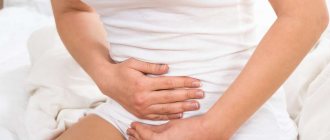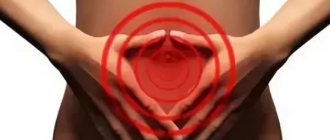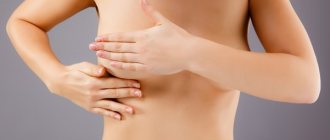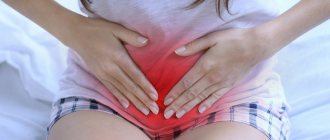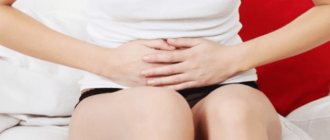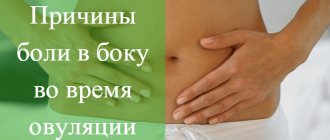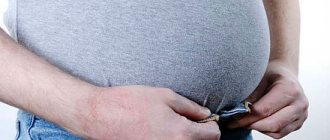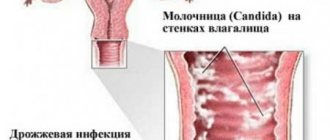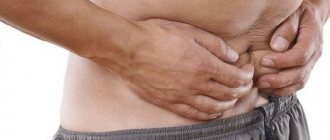Pain in the lower abdomen in the middle of the cycle is a common occurrence in women of reproductive age. When you need to assess the state of women's health, the menstrual cycle becomes one of the main assistants. Its regularity, duration, as well as the amount and nature of discharge can say a lot about whether a woman has certain gynecological problems. Another factor that interests specialists is whether a woman experiences pain in the middle of the cycle or at the beginning.
It is worth noting that many women experience pain in the abdomen or side. However, it must be taken into account that they are not always a consequence of natural cyclical processes in the body. Sometimes this is one of the manifestations of serious pathologies.
Pain as one of the signs of ovulation
The duration of the menstrual cycle for most women is 24-35 days. If the cycle lasts 28 days, then ovulation occurs approximately in the middle and can cause nagging pain, as well as other discomfort. The duration of discomfort usually varies from 3 hours to 2-3 days. Moreover, they can be both frequent and periodic.
It must be taken into account that every woman’s body is individual. Therefore, ovulation will occur approximately on day 20 of the cycle for those who have a cycle lasting 35 days. But at the same time, there are many women whose cycle lasts no more than 24 days. In such a situation, discomfort will most likely appear around the 10th day of the cycle.
Also, the time of ovulation may be influenced by certain factors. For example, late ovulation is typical for women who have irregular menstrual cycles or hormonal imbalances. If a woman had emotional overload or stress, increased physical activity, or had too passionate sex, ovulation may well begin on the 10th day from the start of her period.
The intensity of the pain depends on the following factors:
- character traits - creative, sensual people feel discomfort more intensely;
- the presence or absence of gynecological diseases (with diseases, pain will increase);
- individual perception of pain - the higher its level, the less pain in the lower abdomen will be in the middle of the cycle.
The main thing to remember is that ovulation does not affect diseases of the genitourinary system . In addition, regardless of intensity, pain does not pose a danger to a woman’s reproductive function.
But if the discomfort does not disappear after a few days, you should immediately consult a doctor. Most likely this will indicate the development of gynecological pathologies.
Why does pain occur?
Fears caused by ovulatory pain are mainly associated not with the intensity of the sensations, but with a lack of understanding of their nature. And if during menstruation a large amount of tissue of the uterine mucosa peels off, the organ contracts, putting pressure on the nerve roots, then the release of the female reproductive cell is not accompanied by anything like that. Then why does your stomach hurt during ovulation?
There is only one natural explanation, but it includes several components:
- the pressure itself on the walls of the Graafian bubble cannot be insensible;
- after rupture of its membrane and damage to the blood vessels, the contents enter the abdominal cavity, which provokes pain;
- the uterus does not remain motionless, but under the influence of hormones and fluid seeping onto its surface from the damaged follicle, it also contracts;
- the ovary also stretches during the process of egg development, when it is almost complete;
- the fallopian tubes, when the female gamete moves through them, can contract, causing discomfort;
- Emotionally unstable women may experience pain due to excessive fear of the event.
And yet, in 70% of cases of characteristic abdominal discomfort, when menstruation is still far away, pathological conditions are to blame. The reason may lie in the field of gynecology, surgery, gastroenterology or endocrinology.
It is not surprising that those who notice the described syndrome in the middle of the cycle are interested in where the stomach hurts after ovulation. Since the main event in this period occurs in the ovary, the main sensations occur in the one in which the follicle ruptured. That is, right or left.
It should also be taken into account that the whole process is controlled by hormones. And for them, the uterus and mammary glands are also targets. Therefore, discomfort on the days of ovulation can normally be felt in these organs.
A more pleasant reason (for those who want it) is pregnancy. And if, a week after ovulation, the lower abdomen feels tight, it is possible that this is the body’s way of notifying that the germ of a new life has appeared in it. Some pain may occur at the moment of fertilization of the egg, its movement through the fallopian tube, and then implantation into the uterine mucosa. And it can be felt for more than 2 days, more likely 5 - 7. And if there is also discomfort in the mammary glands, after 7 - 10 days it is worth doing a test.
Pathological causes of ovulatory pain
Spasms and cramps in the abdomen in the area of the ovary during the release of the egg do not always have physiological causes. In 70% of such cases, specialists diagnose one of the following pathologies:
| Disease | How does it affect |
| Hormonal disorder | Failures can be different, and without treatment they quickly get worse. Therefore, the slightest change in well-being in the middle of the cycle should prompt you to go to the clinic. |
| Endometriosis | The fact that after ovulation the lower abdomen hurts, and closer to menstruation the sensations increase, is not its only sign. The presence of cells similar to those that make up the mucous membrane of the uterus in other parts of the reproductive system, especially in the gonads, also causes bleeding in the intervals between menstruation. |
| Ovarian cyst | A neoplasm on one of the organs or both creates obstacles to the development of follicles and the release of the egg. Overcoming them is accompanied by pain and deterioration of the general condition. |
| Ectopic pregnancy | Ovulation is the only chance for conception. But the fertilized egg may not implant into the wall of the uterus, as it should, but attach inside the tube or in the cervical canal. If your stomach hurts after ovulation, pregnancy of this kind cannot be ruled out. |
| Appendicitis | The inflamed area of the intestine may be located in approximately the same area as the right ovary. And if appendicular colic coincides with ovulation, at first glance the sensations will be similar. |
| Salpingitis | With it, the inflammatory process affects the fallopian tubes, which cannot but cause pain. In its intensification, ovulation becomes a provoking factor. And although the ovaries and fallopian tubes are different organs, they all belong to the reproductive system, the condition of some inevitably affects others. |
| Varicose veins of the pelvis | Ovulation causes pain in the lower back and abdomen due to increased blood supply in this area, that is, it becomes very sensitive. This property is also increased by the disease and the ingress of fluid from the damaged follicle into the abdominal cavity. |
| Adhesions in the pelvis | Pathological tissue fusion can occur as a result of chronic inflammation of the reproductive organs or after the acute period has subsided. Naturally, there is less space in the pelvis for the unhindered release of the egg. During the process of its release, newly formed tissues may be affected. |
| Formations on the internal reproductive organs | This is not just about benign tumors of the ovaries and uterus. Cancer diseases do not show themselves for a long time, but individual minor changes in the functioning of organs can be used to understand the seriousness of the problem. One of these is the appearance of pain during ovulation. |
| Mastopathy | Almost all diseases of the mammary glands are hormone-dependent. This fully applies to benign neoplasms in them. If you are ovulating, your breasts hurt, your stomach feels uncomfortable, you cannot rule out the influence of estrogen on the tissues that have grown in the mammary glands. |
https://youtu.be/—3BAOMZp2Q
How can you tell if discomfort is related to ovulation?
One of the main features of such pain is its localization on only one side. From where the reproductive cell emerges in a given cycle. Therefore, if a woman feels that her left ovary hurts, this indicates that it is from there that the egg is released. Next month discomfort will be felt in the right side. However, there are cases when, in one cycle, germ cells come out of two appendages of the uterus. In this case, the pain may be girdling in nature.
Also, the onset of ovulation may be indicated by the appearance of additional symptoms:
- Change in the nature of vaginal discharge - it becomes more liquid and resembles the white of a raw egg in appearance. The reasons for these changes are related to the need to create optimal conditions for the penetration of sperm into the uterine cavity and fertilization of the egg.
- Change in color of the discharge - it becomes transparent and may contain minor splashes of blood.
- Increased sexual desire. This is a completely natural phenomenon, since ovulation is the best time to conceive a child.
- There is increased sensitivity and soreness of the mammary glands. The sensations stop with the onset of menstrual periods.
Diagnostic procedures
The first doctor a woman should contact with a complaint of pain in the lower abdomen is a therapist. After an initial examination, which consists of palpation of the peritoneum, he refers the patient to a gynecologist or surgeon, sometimes to both specialists at the same time. In addition, laboratory tests of blood and urine are prescribed to identify signs of an inflammatory process in the body.
Gynecological examinations include:
- Colcoscopy is an examination of the cervix to detect pathological changes in the tissue. After applying a special composition to the mucous membrane, healthy cells change color, but sick cells remain the same. Changes are detected during examination using a speculum inserted into the vagina.
- Hysteroscopy is a minimally invasive technique for examining the intrauterine cavity using a special device - a hysteroscope. Since its insertion requires maximal expansion of the cervical canal - the cervix, the manipulation is carried out under general anesthesia. The technique allows you to combine examination with minimally invasive surgery - removal of polyps, remnants of the fertilized egg or intrauterine contraceptive device (IUD). Using a hysteroscope, tissue samples are taken for further examination.
If a sexually transmitted infection is suspected, a scraping of the mucous membrane is made for bacterial culture. This way chlamydia and gonorrhea are detected.
An ultrasound examination of the pelvic organs is also carried out, which makes it possible to detect functional and structural disorders in the organs of the urinary and reproductive systems. Ultrasound in women is performed in two ways: abdominal - through the anterior wall of the abdominal press (pathologies of the kidneys and bladder, or inflammation of the appendix are determined), and transvaginal - through the vaginal entrance (if gynecological diseases are suspected). To clarify the results, ultrasound of the pelvic organs is supplemented with computed tomography and magnetic resonance imaging.
Effective ways to relieve ovulatory syndrome
Even if a woman is convinced that discomfort is associated with ovulation, she must consult a specialist. After an examination and additional research, he will be able to rule out other causes of pain. Based on the diagnostic results, the gynecologist will prescribe the most optimal treatment.
If no pathologies are identified in the patient, the following recommendations will help her reduce ovulatory syndrome:
- in the middle of the cycle, you should try to avoid stressful situations, excessive emotional and physical stress;
- temporary change in diet with the exclusion of all products that increase the load on the gastrointestinal tract (we are talking about strong tea and coffee, legumes, white cabbage, chocolate, as well as all fatty or spicy foods);
- Drugs that suppress muscle spasms (No-shpa, Spazmalgon, Spazgan) will help eliminate pain in the ovary;
- non-steroidal anti-inflammatory drugs (this can be Ibuprofen or Ketoprofen) will not only relieve pain, but also reduce the production of prostaglandins;
- You can also alleviate the condition by taking warm baths with the addition of aromatic oils or herbal infusions. However, such procedures are prohibited for women who have acute infectious diseases or pathologies requiring surgical treatment);
- in some situations, when the patient’s lower abdomen hurts almost every cycle, the doctor may additionally prescribe the use of oral contraceptives.
Ovarian apoplexy
Even physiological processes sometimes end in disaster. So, sometimes during ovulation, not only the follicle ruptures, but also the entire ovary. This life-threatening and reproductive health disease is called apoplexy and requires urgent medical intervention. If the ovary ruptures, massive bleeding develops, which can lead to significant blood loss.
If, after sexual intercourse in the middle of the menstrual cycle, you suddenly develop severe nagging pain in the abdominal cavity, especially in its lower part, accompanied by weakness, dizziness, nausea and vomiting, decreased blood pressure and pallor, immediately call an ambulance and go to the hospital for treatment. Here it is important to provide assistance within several hours and prevent the development of shock.
Other causes of pain
There are many problems and pathologies that can cause discomfort of varying intensity. So, for example, the lower abdomen can hurt even due to prolonged stress. This is due to the fact that when a woman is nervous, the muscle ligaments that secure the organs begin to spasm. As a result, changes in the position of organs or twisting of blood vessels may occur.
The most dangerous conditions that can cause pain in the lower abdomen include:
- development of pregnancy outside the uterine cavity;
- torsion of the cyst stalk or its rupture;
- acute appendicitis, the symptoms of which will be vague at first, but will gradually intensify (and the pain will be right-sided, and then move higher and cover the entire abdominal cavity);
- development of cancer;
- uterine fibroids;
- infectious diseases of the genitourinary system;
- adhesions in the pelvic organs;
- inflammatory processes localized in the female genital organs (usually pain in this case is concentrated in one place and is accompanied by high fever and chills);
- varicose veins in the pelvic area.
Pathological causes of pain
Pain, cramps and a feeling of heaviness in the lower abdomen in women in the middle of the menstrual cycle can also have a pathological etiology. Such symptoms can primarily be caused by diseases of the female reproductive system. These include endometritis - inflammation of the mucous membrane of the intrauterine cavity, endometriosis - pathological growth of the endometrium, inflammation of the ovaries and fallopian tubes (adnexitis), rupture of the ovarian cyst, torsion of the cystic pedicle, intrauterine adhesions, fibroids and fibroids. In addition to painful sensations, they may be accompanied by brown discharge, sometimes with an unpleasant odor, and even bleeding.
Non-gynecological causes of hypogastric pain syndrome include:
- Sexually transmitted diseases such as chlamydia or gonorrhea.
- Acute or chronic cystitis is an inflammation of the bladder, characterized by frequent urination and a burning sensation in the ureter.
- Proctitis is an inflammatory process of the rectal mucosa.
- Hemorrhoids are inflammation of hemorrhoids located near the anus.
- Cracks in the anus - in this case, the pain worsens at the time of defecation.
- Intestinal obstruction - it can be caused by both a neoplasm in the abdominal cavity and the accumulation of feces caused by constipation.
- Inflammation of the kidneys - pyelonephritis. With this disease, the body temperature rises, pain appears when urinating, and the lower back ache.
- Renal colic - this pathology is characterized by an acute manifestation of abdominal pain syndrome, sometimes leading the patient to a state of shock.
- An attack of kidney stones or urolithiasis, along with pain, causes difficulty in the outflow of urine, which acquires a cloudy reddish tint.
- Appendicitis - the irradiation of pain depends on the location of the vermiform appendix of the cecum, which does not have a clear localization in the abdominal cavity. The appendix can be located either near the stomach or reach the pelvic area, then its inflammation causes pain in the lower abdomen.
When is urgent medical attention needed?
A woman needs to consult a doctor as soon as possible or call an ambulance if she notices the following symptoms:
- body temperature rises steadily;
- pulls the lower back in the middle of the cycle for a long period of time (more than 24 hours);
- feeling sick, feeling the urge to vomit;
- the ovary constantly hurts, the patient’s condition continues to deteriorate;
- a woman may suddenly faint;
- bleeding occurred (regardless of the intensity of the discharge);
- the patient has undergone gynecological operations or diseases of the reproductive system in the past;
- the ovaries hurt while taking medications to stimulate ovulation.
Problems with women's health, even if they seem completely harmless and insignificant, should be addressed by a specialist. Self-medication is strictly prohibited! This can result in serious problems for a woman. At best, they may be related to the functioning of the reproductive system. Some pathologies can threaten the patient’s life and require emergency surgery.
https://youtu.be/qsGuhLJwFPA
Pain in the middle of the cycle - ovarian pathology
Pain in the middle of the cycle may relate to ovarian pathologies. This pain occurs in the form of an attack and is localized in one of the sides of the body - left or right. It all depends on which ovary is inflamed.
The cause of the inflammatory process of the ovaries is organ rupture, torsion, malignant or benign neoplasms. Such pain can be aggravated by pathologies such as irritation of the abdominal cavity, as well as ovarian ischemia.
This kind of pain is quite easy to distinguish, as it is quite severe. And its amplitude increases if blood begins to rapidly accumulate in the ovary.
Therapy and prevention
Pain in the hypogastric region, explained by physiological causes, does not require special treatment and goes away on its own as the situation normalizes. If necessary, short-term use of non-narcotic painkillers - Analgin, Pentalgin, Baralgin - is acceptable.
Therapy for pathological pain in the lower abdomen depends on its etiology and nature. For endometriosis, as well as in the early stages of fibromatosis, the course of treatment includes hormonal agents. Inflammatory processes are extinguished by antibiotic or antibacterial drugs taken as prescribed and under the supervision of a physician.
As you know, the menstrual cycle is the main assistant in assessing the state of women's health. By its duration, the presence or absence of pain during menstruation, the appearance of bloody discharge, one can judge whether there is any gynecological problem or whether the woman is healthy. One of the characteristics of the menstrual cycle is pain during ovulation, but this condition is observed only in 20% of women of reproductive age.
